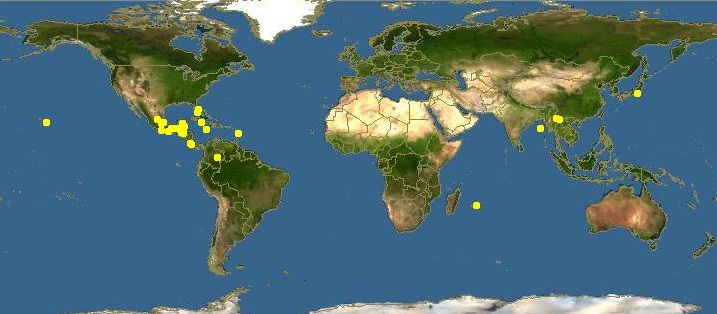Difference between revisions of "Acacia cornigera"
(created page for transclusion) |
|||
| (9 intermediate revisions by 4 users not shown) | |||
| Line 1: | Line 1: | ||
<onlyinclude> | <onlyinclude> | ||
| − | {{botanics_info|image: | + | {{botanics_info|image:Acacia cornigera.jpg|Acacia cornigera| |
| − | * | + | * Presence of DMT in bark indicated but details lacking, needs confirmation (Ratsch 1998 ref. Trout's Notes) |
}} | }} | ||
</onlyinclude> | </onlyinclude> | ||
| − | |||
| − | == | + | == General Plant Info == |
| + | '''''Acacia cornigera''''' or '''''Vachellia cornigera''''', commonly known as '''Bullhorn Acacia''' ([[family (biology)|family]] [[Fabaceae]]), is a swollen-thorn tree native to [[Mexico]] and [[Central America]]. The common name of "bullhorn" refers to the enlarged, hollowed-out, swollen thorns (technically called '''stipular spines''') that occur in pairs at the base of leaves, and resemble the horns of a steer. In [[Yucatán]] (one region where the bullhorn acacia thrives) it is called "subín", in [[Panamá]] the locals call them "cachito" (little horn). The tree grows to a height of {{convert|10|m|ft}}. | ||
| − | {{Page Footer| | + | == Geographic distribution == |
| + | [[File:Cornigera-worldmap.jpg]] | ||
| + | |||
| + | |||
| + | == Identification == | ||
| + | |||
| + | |||
| + | == Alkaloid content == | ||
| + | May be psychoactive, as the root is used as an aphrodisiac, and may have been added to the Central American [[balché]] beverage.<ref name="Rätsch" /> Claims of tryptamines in this species<ref name="fachforum">[http://web.archive.org/web/20080626102405/http://www.naturheilpraxis.de/exclusiv/nh-online/2005/nhp05/a_nh-ff02.html Naturheilpraxis Fachforum (German)] {{dead link|date=March 2011}}</ref> might be speculation. Research needed. | ||
| + | |||
| + | == Extraction == | ||
| + | |||
| + | |||
| + | == Other uses == | ||
| + | The [[Spine (botany)|thorn]]s of ''V. cornigera'', are often strung into unusual necklaces and belts. In [[El Salvador]] the horn-shaped thorns provide the legs for small ballerina seed dolls which are worn as decorative pins. | ||
| + | |||
| + | == Cultivation == | ||
| + | |||
| + | |||
| + | == Suppliers == | ||
| + | |||
| + | |||
| + | == Links == | ||
| + | *[http://www.ambergriscaye.com/fieldguide/bzplants.html Vegetation of Belize] | ||
| + | *[http://www.arnica.csustan.edu/biol1010/com_ecology/community_ecology.htm Community Ecology] | ||
| + | *[http://www.backyardnature.net/yucatan/acacia-t.htm Backyard Nature] | ||
| + | |||
| + | [[Category:Botanicals]] | ||
| + | |||
| + | == Reference == | ||
| + | <references/> | ||
| + | {{Page Footer|Botanicals|DMT Containing Plants}} | ||
Latest revision as of 07:18, 2 February 2015
| Acacia cornigera |
|
|---|---|
|
Contents
General Plant Info
Acacia cornigera or Vachellia cornigera, commonly known as Bullhorn Acacia (family Fabaceae), is a swollen-thorn tree native to Mexico and Central America. The common name of "bullhorn" refers to the enlarged, hollowed-out, swollen thorns (technically called stipular spines) that occur in pairs at the base of leaves, and resemble the horns of a steer. In Yucatán (one region where the bullhorn acacia thrives) it is called "subín", in Panamá the locals call them "cachito" (little horn). The tree grows to a height of Template:Convert.
Geographic distribution
Identification
Alkaloid content
May be psychoactive, as the root is used as an aphrodisiac, and may have been added to the Central American balché beverage.[1] Claims of tryptamines in this species[2] might be speculation. Research needed.
Extraction
Other uses
The thorns of V. cornigera, are often strung into unusual necklaces and belts. In El Salvador the horn-shaped thorns provide the legs for small ballerina seed dolls which are worn as decorative pins.
Cultivation
Suppliers
Links
Reference
- ↑ Cite error: Invalid
<ref>tag; no text was provided for refs namedR.C3.A4tsch - ↑ Naturheilpraxis Fachforum (German) Template:Dead link

